
Report
Nato Centre of Excellence for Military Medicine
The second NATO-wide conference on Force Health Protection took place in Budapest, Hungary on 23 – 26 June 2014. This followed on from the very positive experiences of the first conference held in June 2012 in Munich which focused on health surveillance. The Budapest conference had an expanded scope and was held in the NATO Centre of Excellence for Military Medicine’s (MILMED COE) “hometown”.
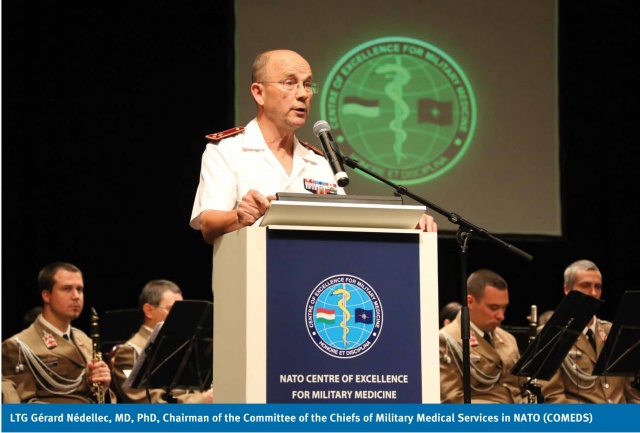
MILMED COE organized the Force Health Protection NATO Conference 2014 in cooperation with the NATO COMEDS Force Health Protection Working Group, the Hungarian Defence Forces and the Medical Centre of the Hungarian Defence Forces, the Semmelweis University, the University of Pécs Medical School and the Medical Corps International Forum (MCIF).
MILMED COE would like to thank the contribution of all the partners, lecturers and participants, and also, LTG Gérard Nédellec, MD, PhD (FRA), Chairman of the Committee of the Chiefs of Military Medical Services in NATO (COMEDS) for his support and opening speech. Furthermore, a special thanks goes to the Chairs of the Scientific Board of the conference: Colonel Prof. Dr. Jean-Baptiste Meynard, Chair of the NATO Force Health Protection Working Group and deputy director of the French Forces Epidemiology and Public Health Centre (CESPA), Marseille, and Rear Admiral uh (ret.) MC Dr. Christoph Büttner, Editor-in-chief of MCIF. We also thank Lieutenant Colonel Dr. Benjamin Queyriaux, Branch Chief of the Munich-based Deployment Health Surveillance Capability (DHSC), a satellite branch of MILMED COE, for having put together a fantastic scientific programme for the conference.
Attendance at the NATO FHP Conference 2014 was indeed a NATO-wide event, with more than 200 participants - both military and civilian - from 27 countries, of which 74 lecturers from 12 nations (BEL, CAN, CZE, DEU, FRA, GBR, HUN, NLD, POR, ROU, SVK, USA) delivered 81 presentations, organised into 15 themed sessions.
The scope of Force Health Protection is wide and encompasses the promotion, improvement, conservation/protection and restoration of the mental and physical wellbeing of personnel. The Chair of the conference’s Scientific Board, Colonel Prof. Dr. Jean-Baptiste Meynard gave the final evaluation: the conference has reached its aim to provide valuable insight into the actualities of Force Health Protection measures and challenges.
The conference provided an opportunity for stimulating scientific debate in the presence of subject matter experts from a range of disciplines. The main topics covered were communicable and non-communicable disease control, mental health and the care of the wounded soldier from injury to recovery. In addition, there were ample professional networking opportunities to strengthen existing partnerships and develop new opportunities for collaboration. Col. Meynard highlighted that the conference was only the beginning and what follows is the important period of reflection during which delegates can consider whether and how policies and procedures that they can influence need to be finessed; develop their research agenda; and validate their current practice and identify their future learning needs. To facilitate this, the full programme with most of the presentations is available electronically from the MILMED COE website (www.coemed.org)
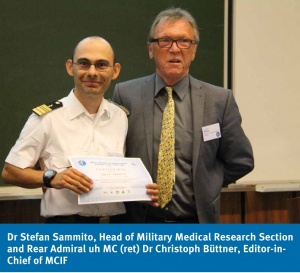
A poster session was also organized, awarding the best poster with a prize of EUR 1000 handed over by Rear Admiral uh (ret.) Dr. Christoph Büttner to Dr. Stefan Sammito, head of Military Medical Research Section, Bundeswehr Medical Service Headquarters, for his poster entitled Obesity Intervention for Military Servicemen - Results after Two Years of Intervention.
Moreover practical case studies and simulation workshops organized in small groups, as well as an industry exhibition took place at the conference.
The 2014 NATO FHP Conference raised the bar and there is already interest from France and the US European Regional Medical Command to host a future gathering. NATO MILMED COE looks forward to supporting this. Until then, we present a series of mini-articles that showcase some of the highlights from this year’s scientific programme.
Mental Health – Battle Stress Management and Post-traumatic Stress Disorder
“Although military personnel are trained for combat and peacekeeping operations, accumulating evidence indicates that deployment-related exposure to traumatic events is associated with mental health problems and mental health service use” (Sareen et al, 2007)1. All services which are providing soldiers to missions abroad, especially to ISAF (International Security Assistance Force) in Afghanistan, are reporting an increasing number of soldiers with mental health disorders after their deployment. It is such an important topic that at the conference, top ranking scientific representatives provided their experiences and fully one third of the lectures addressed mental health disorders. Many of presentations provided detailed results of mental health incidences in their home countries.
A very detailed study was presented by Prof. Dr. Hans-Ulrich Wittchen from the Institute of Clinical Psychology and Psychotherapy and Centre for Clinical Epidemiology and Longitudinal Studies of the Technical University of Dresden. He provided an overview about “Rates of Mental Disorders among German Soldiers Deployed to Afghanistan”2. Based on a random stratified sample of 1599 German soldiers (response rate (RR) 93%, n=1483), the team assessed subjects 12 months after returning from deployment to Afghanistan and compared findings to 932 never deployed controls (RR: 95%, n=889). Interviews were conducted by trained non-military clinical interviewers using the DSM-IV-TR-Composite International Diagnostic Interview (CIDI-military). Outcome measures were 12-month prevalence and incidence of PTSD, anxiety, depressive, substance use disorders among other DSM-IV-TR mental disorders. Compared to controls, previously deployed soldiers had a higher 12-month incidence (OR: 4.3) and prevalence (OR: 2.4) of PTSD, anxiety (OR: 3.6, 1.4), and alcohol use disorders (OR: 3.5, 1.9). They also had higher rates of multiple diagnoses (MR: 1.72) and higher anxiety distress scores (Wittchen et al. 2013). Critical conclusions revealed by the research but not covered above include:
- Improved diagnostic screening for prior mental disorders among deployed soldiers is likely to reduce morbidity by over 50%.
- Prior psychopathology (previous anxiety and subclinical PTSD symptoms) is by far the most powerful risk factor for mission related disorders
The most important point elucidated by the data outlined above is that the risk of other mission-related mental disorders is considerably higher than the risk for PTSD. This observation was also emphasized by lectures presented by researchers from France and The United Kingdom.
Prof Wittchen also compared the rates of deployment-related traumatic events and PTSD in US and Germany: 2.9 % in the German study versus up to 20 %, in various US studies. He mentioned that “US and UK studies report rates for “probable PTSD”, not strictly according to DSM-IV criteria”. However, regarding the varying prevalence of PTSD cases, it was mentioned that were the DSM-IV criteria used, the US numbers would most likely be significantly lower.
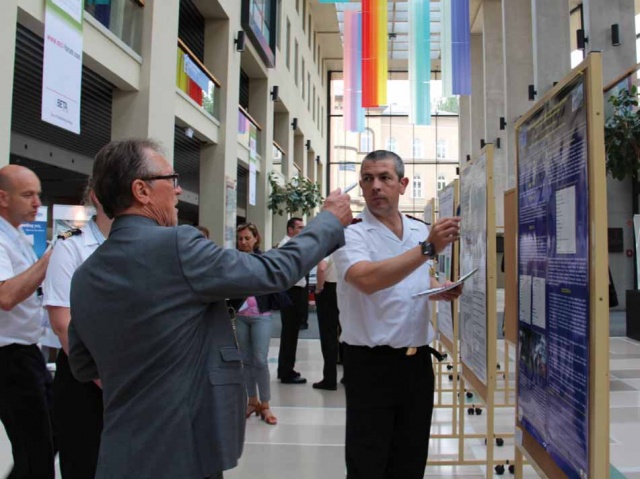
Cpt. Agnes Gyorffy, Clinical Psychologist and head of Mental Health sub-department of the Hungarian Military Hospital, mentioned that “after a mission, 20% of the soldiers decide to leave the military organization3. In the military profession 3–4 missions can be taken by the individual with the preservation of the ability to reintegrate oneself to civilian society. Family and relationship problems could be seen after the second mission. Symptoms of burn out are presented after 7-9 years in military profession or after 3-4 missions”. Her observations are in line with the experiences of other lectures during the conference.
Additional information was provided concerning the prevention of mental diseases after deployment. Priv. Doz. Dr. med. Peter Zimmermann, Bundeswehr Hospital Berlin, German Armed Forces Centre of Military Mental Health, provided an overview of his latest research and a new approach: “Personal Values in German soldiers after deployment – Associations with Mental Health and Resilience”4. He mentioned “that after military deployment, soldiers are at an increased risk of developing posttraumatic psychiatric disorders. While it is known that for non-military members, a personnel value system is correlated with symptoms, this has not yet been examined within a military context. His group completed the “Schwartz’s Portrait Values Questionnaire (PVQ), the Posttraumatic Stress Diagnostic Scale (PDS), and the 11-item version of the Resilience Scale (RS-11) by 117 soldiers of the German Armed Forces who had recently been deployed to Afghanistan (40 undergoing initial psychiatric treatment and 77 untreated)”
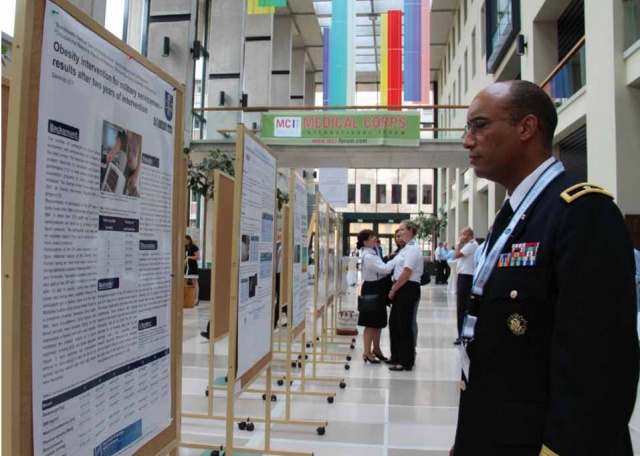
“The results of the logistic regression showed that the value types of hedonism and power were protective with respect to symptoms, while tradition and universalism were protective and all four showed significant correlation with the probability and severity of PTSD and whether the participant was in treatment or not. The effects were partially mediated by the RS-11 scale values” (Zimmermann et. al. 2014). Zimmermann concluded that value types seem to be associated with psychiatric symptoms in soldiers after deployment. These results could contribute to the further development of therapeutic approaches.
Dr. Amy B. Adler from the US Army Medical Research Unit – Europe of the Walter Reed Army Institute of Research explained during her lecture “Promoting Psychological Resilience in the Military” that “under conditions of high levels of combat experience, Combat Operational Stress Control (COSC) leadership was associated with lower levels of PTSD symptoms even after controlling for rank and general leadership”5.
The topic of predevelopment preparation and screening was covered in other lectures. Priv.-Doz. Dr. Jens T. Kowalski from Berlin Bundeswehr Hospital Centre for Military Mental Health – Research Section introduced in his presentation “CHARLY - Multimedia- based pre-deployment psychological training – a new approach to enhance soldiers’ resilience.”6
Kowalski explained, that CHARLY is a technology based preventive tool, developed and commissioned by the psychological service of the German Armed Forces. “CHARLY provides an innovative multimedia training platform for psychosocial support. It supplements existing psychological and supervisory units and helps to efficiently and sustainably increase the ability of military personnel to cope successfully with deployment stress. CHARLY uses a wide range of multimedia capabilities, such as videos, animated comic illustrations and various methods of interaction. An integrated video coach supports participants by moderating and explaining the course content. CHARLY has a biofeedback interface using skin conductance for feedback.” Dr. Kowalski summed up, that the Bundeswehr is “going to implement CHARLY as a standard pre-deployment prevention tool and this is what CHARLY was built for. Not more but definitely not less than that.”
Finally different types of therapy were presented, for example the Interdisciplinary Counselling Program of the German Armed Forces (Lt. Col. Christian Zechel, M.D., German MoD)7. This holistic support and advice process for military members and their families not only focuses on the soldier and treatment of their mental disease but also provides treatment, support and counselling for family members who are often facing great challenges and problems caused by the illness of the soldier. Additionally adjuvant therapies were discussed, such as the use of Japanese martial arts in coping with deployment related stress (Sergeant Major Wolfgang Holzmann)8 or yoga and dogs (Maj M. Bilodeau, MD, M. Sc., FRCPC MH Clinical Leader, CFB Valcartier)9.
In summary, all presentations addressed the identification and sharing of best practices for prevention, early detection and care with an active approach for treatment. However, the representatives of the medical services continue to note the multitude of undiagnosed cases and the need for more treatment for soldiers with mental health illnesses. MILMED COE will increase its contribution to this work and is interested in supporting the activities of the NATO Mental Health Panel (NATO MHP) to facilitate a Community of Practice for Military Mental Health along with other NATO MHP projects and programmes. Also, MILMED COE is supporting the following pilot course: Military Psychosocial Incident Management Course. This course is scheduled to run from the 8th-10th of October 2014 and will take place in Brussels (more information on the website of MILMED COE, www.coemed.org).
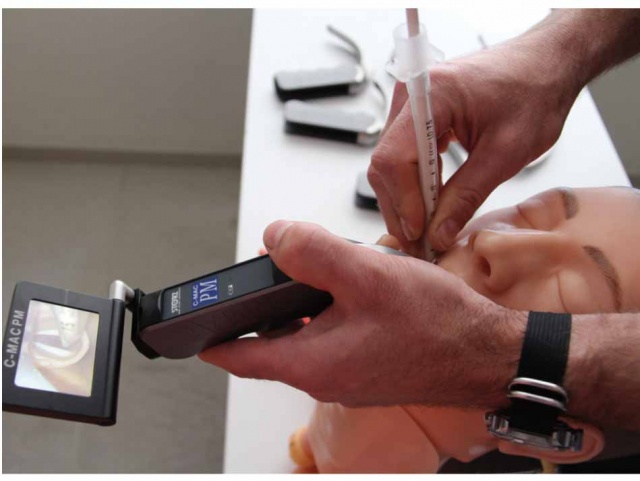
Medical Evacuation and Casualty Treatment
MEDEVAC is one of the most important capabilities of the medical rescue chain. Therefore, many experts provided lectures on their experiences regarding this topic. LTC Dr Jérôme Bancarel, Deputy Branch Head of Aeromedical Evacuation Control Center (AECC) of the European Air Transport Command (EATC) explained how the requests for strategic aeromedical evacuation (Strat AE) are managed, using the military air transportation assets of the EATC partner nations as effectively and efficiently as possible, in this command10. The standard work environment within the European Air Transport Command (EATC) is one of multinational cooperation and team work. This multinational cooperation in the field of Strat AE increases the efficiency by sharing of national resources, always keeping the national caveats and prerogatives for patients’ transport into account. It was commented that in multinational medical teams, the nationality of the responsible person for the medical equipment and the nation of origin of the aircraft have to be same.
“By centralizing the Command and Control for Strat AE within the multinational AECC, information sharing and common overview is enhanced”, LTC Bancarel stated. Additionally, multinational initiatives like this facilitate a deeper understanding of interoperability, increase flexibility of the system and make national military services and their staff more open to working with systems from other member nations. Finally, LTC Bancarel emphasized the necessity for the AECC of having a single Point of Contact for the coordination of Strat AE in each EATC partner nation, to ensure clear lines of communication.
This lecture underlined, once again, the necessity of interoperability and standardization in MEDEVAC procedures. LTC MC Dr Tilmann Moll - Flight surgeon of Ministry of Defence – Special air mission wing - provided in his lecture, “Practical experience in missions with large aerovac aircraft”, details concerning mission standardization. “During a mission processes should be in place to develop teamwork and cooperation. Standardized pre-mission briefings and duty assignments and regulations need to be reviewed as do standardized communication protocols and clinical documentation requirements. After a mission there should be a standardized debriefing to include mental hygiene and support, after mission report and lessons identified.”
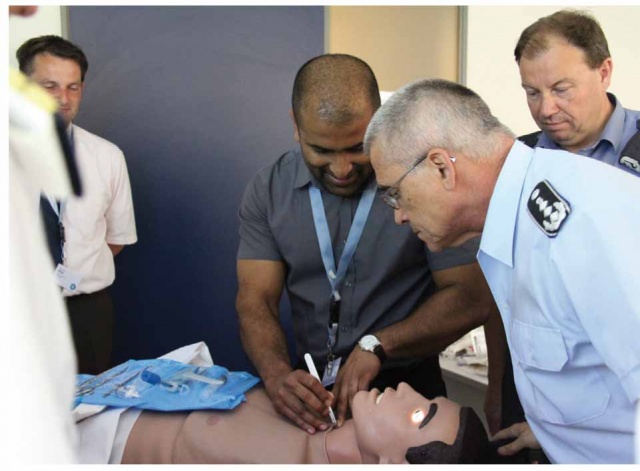
In addition to the general information developed above, workplace specific orientation is needed to optimize the functioning of the team. Specifically aviation physiology, nine stresses of flight, safety on ground, safety on board must be institutionalized. These systems are the basis of DEU developed system for large aerovac aircraft with multilevel coordination and evaluation based on practice11.
Complementing the best practices outlined above were discussions on discipline, security, hygiene and public relations training. Many participants reported a need for training on what information and documents could be shared and they also commented that disseminating finalized lessons identified / lessons learned is an area that needs improvement. Finally, psychological aspects of these kinds of missions are mental hygiene, providing intimacy, discretion for patients within limitation, handling the pressure of time and press, and overall preventing chaos.
The importance of cooperation is not only critical between nations providing multinational service and care, but also at the national level between military medical and rescue services and civilian actors in the overlapping field of action. An example presented by LTC Dr Nadine Mandau - of The German Naval Medical Research Institute at Kiel -is the coordination and cooperation between civilian aviation safety services and German Naval Search and Rescue (SAR) helicopter squadron12. By coordinating across common areas of interest (such as providing SAR over marine environments) capabilities can be shared redundancies reduced and expenses minimized. Having the military to take responsibility for actions within its normal working environment during peacetime and within the homeland opportunities for skill maintenance are realized. Strictly separated military and civilian activity on the same field of action is outdated. Interoperability has the potential to improve the capabilities of both sides.
LTC Dr. Mandau summarized a number of the special medical challenges involved in marine environment SAR missions. Among those mentioned were difficult extrications, limited personnel, extended transport time, and multiple effect of long time immersion in cold water (hypothermia, incapacity to act, time of useful consciousness, death after being rescued alive, due to reallocation of cold blood within circulation and sudden termination of the outer pressure by the seawater). Dr. Mandau stated that these examples, among others, underline the requirement for special equipment, specially trained personnel and aircraft with appropriate endurance and ongoing skills maintenance.
MAJ Dr. Sandrine Duron-Martinaud - from the French Armed Forces Center for Epidemiology and Public Health, Marseille/ France –presented the findings from a French cross-sectional descriptive study introduced by in his lecture “Taking risks during medical evacuations - the pilot point of view”. Based on an anonymous retrospective self-questionnaire collected between March and April 2011,13 according to the pilot point of view, medical evacuation missions are higher risk due to the mixing of technical and social skills where medical information influence the pilot’s behaviour and decision making process. The study concluded that during Medical Evacuation flights, risk is doubled for helicopter pilots and that non-verbal communication has a high impact. Notably, the study found that half of the pilots stated that Aeromedical evacuation missions are “at-risk missions” and a quarter of pilots went beyond their (technical or human) limits. Additionally half of the pilots reported violating flight safety procedures at least once to save time for a medevac.
Maj Duron-Martinaud highlighted that while communication is part of the culture of both the flight crew and medical staff, communication BETWEEN these two components is problematic. Specifically, “the medical team should receive training on communication process and effects on the flight crew. The medical team does not realize the impact of their behaviour on the decisions of the pilot and how providing unneeded information can adversely affect air team functions.” Based on the outcomes of the study, training on crew resources management (CRM), human factors, communication skills and developing joint training for aircrews and medical teams to harmonies teamwork and enhance cooperation should be recommended.
The increased survival rate, even in case of severe injury, is due to improved treatment during the entire evacuation and treatment chain including a sophisticated and high quality STRATAIRMEDEVAC. In acknowledgment of this, Germany has developed the concept of international intensive care as it was explained in the presentation of COL Prof. Dr. L. Lampl PhD and LTC MD B. Hossfeld from Department of Anaesthesiology and Intensive Care Medicine, German Federal Armed Forces Hospital, Ulm, Germany14. During long distance MEDEVACs the goal is to provide the same level of care as would be provided in a medical facility located in the home country. The German Medical Service may provide excellent examples of medical intensive care during repatriation of military and civilian casualties of different nations worldwide.
Burn injuries are one of the most complex types of injury and severely test the expertise, mental endurance and capacity of medical systems as MAJ Dr Radek Pohnán from Prague Military Hospital/ Czech Republic presented in his lecture “Burn injuries in MASCAL situations”15. Dr Pohnán stated that critical to patient outcome is the understanding of the need of rapid transport to a specific burn treatment facility where the expertise in the specialized instruments, equipment and organization, is available. Additionally, as Maj Pohnán concluded, the understanding of the prolonged requirement for treatment, the multiple concurrent injuries and the typical complicated hospital course all impact the patients and healthcare staff.
Ms. Kathleen Martin, RN, MSN-USA, Trauma Nurse Director in Landstuhl Regional Medical Centre – American College of Surgeons Verified Trauma Center, described some of the key milestones in the development of Landstuhl Regional Medical Center (LRMC) as a vital Military Treatment Facility (MTF) within the global continuum of casualty evacuation.16 “The events of September 11th, 2001 led to the development of the Joint Trauma System, the world’s largest and most complex inclusive trauma system stretching over thousands of miles and three continents. The early trauma program at LMRC encompassed all surgical disciplines to include general surgery, orthopedics and surgical subspecialties, as well as integral medicine subspecialties of pulmonary, critical care, infectious disease, and gastroenterology along with specialty nursing disciplines. The concept of the trauma program was to establish continuity of care between the various departments and to establish timely multidisciplinary care. LRMC sought to validate the efficacy of its trauma program by being the first medical facility outside of the United States to be verified by the American College of Surgeons as a trauma centre, with verification as a Level II centre in 2007. The hospital was re-verified in 2010, and with enhanced research and graduate medical education, achieved verification as a Level I trauma centre in 2011.” Ms. Martin stated in her presentation that the survival rate of the Total Trauma Patients Admitted to LRMC is 99.6% (119 Deaths out of 18289 Trauma Patients Admitted to LRMC)”. Ms. Martin also commented that the development of highly specialized teams, such as the Acute Lung Rescue Team, has contributed to the increased survival rate. She concluded her presentation by pointing out that a complex and comprehensive trauma system includes the systems described above but also other “ancillary” systems such as organ harvesting for organ donation.
New technology and methodologies have made possible a number of changes in patient treatment and medical logistics. As LTC Dr Miloš Bohoněk MD PhD from Prague Military Hospital/ Czech Republic expressed in his presentation “Blood supply of field hospitals army of the Czech Republic”17. The supply of blood has been, and is, challenging. He mentioned the limited shelf-life, special transportation and handling needs and the strict administrative and clinical requirements as examples of some of the difficulties. He emphasized that from the military perspective, the distance from collection and processing points to the location of use is complicated by the often very short expiration dates. Additional problems were also listed by LTC Dr Bohoněk including various medical-legal requirements such as the requirement for certification of freedom from infectious organisms, approval for use of blood products from a country other than the patient’s country of origin and the limitations of airlift capabilities.
According to the presenter the concept of the versatile field blood transfusion facility was developed and the Field Blood Transfusion Unit was created. The Unit, designed in telescopic container ISO 1C, can provide blood supply used all known methods: 1/ use of frozen blood products (RBCs, PLTs and Plasma), 2/ use of fresh RBCs shipped from home country or 3/ collection of blood in the field (“walking blood bank”). “This is a self-sufficient unit consisting of biochemical-haematological and microbiological laboratory capabilities, technical expertise and the ability to collect, processing and provide blood products while maintaining the required equipment and supplies. The result is an expedient and effective method for providing blood and blood products near to the point of use”.
Civil-military cooperation / Education, simulation & training
Based on the collected and validated experiences and lessons learned cooperation between civilian and military services, cooperation is very important and beneficial for both sides. A lot of lectures provided their experiences about this topic.
“Military and disaster medicine deals with severe situations, most of the time with mass casualties. But even in case of a few injured, our aim is to decrease the detrimental effect of trauma or any noxious effect. The way we do it is damage control”, was stated and explained in the outstanding presentation of Prof. Dr. Janos Gal, Vice-Rector for Clinical Affairs, Semmelweis University, Budapest, Hungary; and Head of the Department of Anaesthesiology and Intensive Therapy, Semmelweis University18.
The lecture “Training Programs for Supporting Interoperability in Military Medicine” by Prof. Tit. Istvan Szilard MD., Ph.D., Chief Scientific Adviser, University of Pécs Medical School, Department of Operational Medicine, Chair of Migration Health, gave an overview of (not only) health challenges linked to global migration19. He deeply described the CHANCE project with the aim to train health and social care professionals to work in a multicultural and multi-religious environment. Culturally competent communication at both level – host countries’ partners and clients as well as for the members of the deployed NATO medical corps – is a key element for the successful operation. At last but not least he emphasized the importance of close partnership between his chair and MILMED COE.
As presented by the Hungarian Police Captain Dr Attila Faggyas, military medical processes are becoming more relevant to civilian medical systems as terrorism became daily threat20. Acts of terrorism can lead to chaos, mass casualties with victims experiencing multiple severe injuries, permanent disabilities, psychological disorders, and numbers of dead and injured personnel previously only seen on battlefields; these are conditions which also characterizes military medicine, he concluded. Other than casualty management and direct casualty care, other common factors of military and civilian medical systems include limited resources (equipment, human, professional), limitation of immediate treatment and evacuation, training, the use of and situational modification to medical protocols, equipment, communication, reporting, documentation, casualty movement and tracking , security, and the psychological effects of repeated exposures. Captain Faggyas added that “considering the similarities between civilian and military medicine the employment of the TACTICAL MEDICINE PERSPECTIVE – based on emergency, disaster and military medicine would be a powerful way to potentiate both military and civilian medical systems.”
The lecture of Prof. Dr. Attila Miseta, Dean of the University of Pécs Medical School in “The Involvement of Medical Schools in Civil-military Cooperation” showed the main differences in aims of the civilian sphere and the military organizations21. Normally, the military community is prepared to handle its own challenges, especially their missions abroad. Obviously, there is less space for the civilian community in the combat zone. Disaster handling is one major area for cooperation – a main aim in such an environment is to put together the resources in an effective way. The civilian medical schools have the capabilities and knowledge to support the training of the technical skills for the military medical personnel. As an example, he presented the experiences of the University of Pécs Medical School and MILMED COE during the Emergency Management of Battlefield Injuries (EMBI) Course.
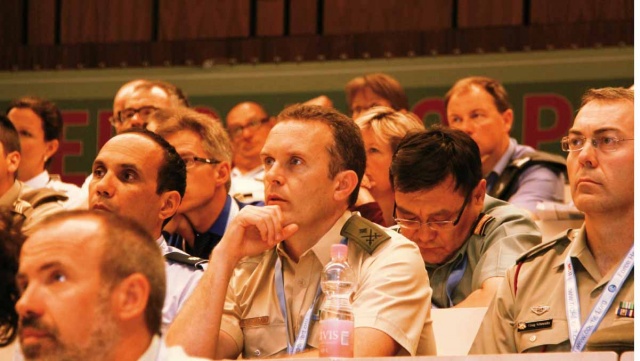
Force Health Protection.
Why is there a gap between evidence, policy and resources?
Scientific discussions always result in more questions than answers. These often relate to the friction that exists when scientific knowledge is put into day to day practice, bearing in mind what is affordable. The gaps in evidence create uncertainty which is compounded further by the current economic paradigm.
Notwithstanding, decisions still have to be made. Making best use of what we have in terms of knowledge and experience will remain the mainstay of our approach; however, emerging threats require the maintenance of situational awareness. It has never been more important for decision makers to keep their eye on the bigger picture.
The 2014 Force Health Protection meeting in Budapest brought together a wide range of experience. Within this section we will distil three distinct but interconnected topics in the field of communicable and non-communicable disease control. They highlight the key dilemmas within Force Health Protection and when considered together, give some insight into the priorities and approach to solving them.
Presentations from Dr. Geeraerts22 from the Belgian MoD, ACOS Well-Being / Health Division and Dr. Berger23 from the French Forces Epidemiology and Public Health Centre (CESPA) covered the thorny subject of Rabies vaccination. They also provided an introduction to the tension between clinical and cost effectiveness. Dr. Geeraerts reported very positive experiences from Belgium’s policy of universal vaccination of service personnel against Rabies. On a population scale, vaccination appears to be safe and effective in preventing disease. In contrast, Dr Berger reported their experience from immunising all troops serving in French Guiana. This casts some doubt on whether this is a cost effective option when compared with the combination of risk stratification, targeted immunisation, aero-medical evacuation and post exposure prophylaxis.
At face value, vaccination sounds like a good idea; however, the question remains about whether simpler measures to avoid exposure were being effectively adhered to in both populations. Vaccination may have an unintended effect on individual risk perception leading to increased risk taking. Although disease in vaccinated individuals following an infected bite is unheard of, rabies is only one of the morbidities associated with animal exposure. Looking at the bigger picture, the lesser morbidities are likely to have greater potential for reducing combat effectiveness. This reinforces the importance of the existing lessons about controls to prevent bites and other exposures occurring in the first place.
The lively debate that followed these sessions highlights the range of paradigms that exist between NATO member states in terms of health economics. The consequence is that approaches to prioritisation and the resulting policy may also differ. This is likely to present an on-going challenge for commanders of multinational forces to reconcile these differences.
A number of presenters24 spoke about the diseases that continue to impact heavily on operational effectiveness. These are principally the diarrhoeal illnesses and tropical diseases. Non-infectious diseases such as noise induced hearing loss and complications of chronic disease25 also featured. The common theme joining all of these is that they represent potentially preventable or avoidable in theatre morbidity.
Dr. Hagen of the military section of the German Bernhard-Nocht-Institute in Hamburg presented an ongoing study about the causes of diarrheal diseases of deployed troops. According to his results the causal agents remained undetectable in about 40 % of the observed cases even after deploying “high-tech” analytic assets like Real Time PCR to the EUTM in Mali. The detectable 60 % reflected the bacterial and protozoan spectrum of a sub-Saharan country with focus on the different E.coli subtypes.
Engagement of military commanders in leading their troops to adopt FHP measures is critical to maintaining operational effectiveness. Therefore, it was surprising and concerning to hear a number of speakers allude to problems they had experienced. Uncertainties remain about the effectiveness of interventions to tackle emerging FHP issues which reinforces the importance of FHP audit to provide that assurance. Notwithstanding, the prevention paradox remains a barrier to effective FHP.
The importance of maintaining situational awareness was highlighted in research from Dr Michel26 relating to the human factors that can influence the performance of personnel involved in the management of a simulated outbreak. Decision making when there is uncertainty is difficult and the tactics adopted suggest a high degree of risk aversion and preference for reducing uncertainty as much as possible. The question then arises about whether teams get bogged down in investigating the minutiae and lose perspective about other things that are happening that may be more important.
When Dr. Michel concluded that “outbreak … management is a complex activity, especially dealing with uncertainty and dynamic environment” it almost seemed that he could see the West Africa disaster coming. Looking again in his presentation could even today be very helpful for those trying to cope with the challenges and uncertainties of the current Ebola outbreak management.
Militaries are regularly faced with the prospect of having to make decisions with incomplete information. This often relates to the tensions between tangible and intangible benefits and costs, available resources and the desired outcome and the political and economic perspectives to the mission. Notwithstanding, decisions need to be made and the salutary warning from Theodore Roosevelt that “In any moment of decision, the best thing you can do is the right thing, the next best thing is the wrong thing, and the worst thing you can do is nothing” still holds true.
In summing up, it is ironic that the phrase “more bang for buck” originates from programme budgeting research conducted by the Rand Corporation for the US DoD during the 1950s. In the current fiscal context there is an even greater imperative to make best use of available military medical resources.
Numerous presentations focused on the complementary importance of medical intelligence and deployment health surveillance to support resolution of the present force health protection challenges. Though from different perspectives, Dr. Queyriaux of NATO MILMED COE’s Deployment Health Surveillance Branch27, Dr. Hupin of the French CESPA28, Dr. Holtherm of the German MoD29 and Dr. Svéd from the Hungarian Armed Forces30 highlighted this topic. Dr. Hupin mentioned the roll of the FRA Medical Intelligence during the beginning (respectively the detection) of the Ebola outbreak in West Africa in March 2014, therewith anticipating its paramount impact until today. Dr. Svéd on the other hand reported on the link between evidence and policy stating that the “introduction of the EpiHUN surveillance system provided an opportunity for mission specific pre-deployment training, in order to minimize proportion of preventable disease”.
Rapid advances in technology have greatly increased the options available for protecting the health of deployed forces. There is a risk that we will forget to use the lessons gained from previous campaigns or create unintended consequences such as moral hazard. Getting the basics right starts with ensuring commanders take responsibility for health, supported by good health intelligence garnered from surveillance and audit.
Conclusion
An essential core message of this conference is that close cooperation and exchange of knowledge with civilian partners in the health sector is of fundamental importance. Infectious chains do not stop at national borders or at barracks’ gates. On the other hand, ongoing operations have shown that experience is gained in the field of military medicine which is of interest and significance for the diagnostics and therapy of every patient, be it military or civilian.
Prevention certainly includes far more than the protection against pathogens but also means “holistic promotion of health” in an interdisciplinary approach. Despite technicalisation, physical demands on armed forces members are increasing – in particular on deployments abroad.
Resistance does not only mean to be physically fit but also to stand up mentally to the effects of stress. Initially, this was underestimated, but ongoing operations have shown that experiences and impressions the soldiers must face during their deployments abroad leave deep mental scars; and regrettably cause mental disorders with a considerable number of soldiers.
We need a strategy for preserving the health of our soldiers on deployment based on the interdependent pillars of resistance, fitness and prevention of avoidable health risks as well as the treatment of health disorders – a strategy which first and foremost requires operations-focused, inter-specialty, multi-disciplinary, and multinational cooperation.
As a Centre of Excellence, we would like to benefit from the lectures, discussions and experience we have collected during the conference. Our task is to contribute to the technical, scientific, and military foundations of a modern, efficient and future-oriented NATO Medical Service, especially during our Lessons Identified/Lessons Learned (LI/LL) Conference and Workshop on 20–22 October 2014 in Budapest.
The enduring challenge for Force Health Protection is to sustain the engagement of military commanders so that they see it as an issue that is integral to their mission and take action accordingly. As technology advances, we will be able to do more things; however, we need to retain sight of the basic lessons that have been learned from rather than risk repeating history. The debate on the specifics and minutiae will continue as will the differences of opinion and policy. However, as members of the NATO community, these differences should be regarded as one of our strengths. This is because, just as in nature, diversity is the key to survival. We look forward to the next gathering to consider Force Health Protection issues in depth.
1 Jitender Sareen, BSc, MD, FRCPC; Brian J. Cox, PhD; Tracie O. Afifi, MSc; Murray B. Stein, MD, FRCPC, MPH; Shay-Lee Belik, BSc (Hons); Graham Meadows, MD; Gordon J. G. Asmundson, PhD, Combat and Peacekeeping Operations in Relation to Prevalence of Mental Disorders and Perceived Need for Mental Health Care Findings From a Large Representative Sample of Military Personnel. Arch Gen Psychiatry. 2007; 64(7):843-852. doi:10.1001/archpsyc.64.7.843 (Sareen et al, 2007)
2 Hans-Ulrich Wittchen, Sabine Schönfeld, Clemens Kirschbaum, Sebastian Trautmann, Christin Thurau, Jens Siegert, Michael Höfler, Robin Hauffa and Peter Zimmermann (2013) - DEU (Rates of Mental Disorders Among German Soldiers Deployed to Afghanistan: Increased Risk of PTSD or of Mental Disorders In General?) J Depress Anxiety, 2013, 2:1 (Wittchen et al., 2013)
3 CPT Agnes Gyorffy - HUN (PTSD and other forms of traumatisation and their handling in the HDF)
4 Peter Zimmermann, Susanne Firnkes, Jens T. Kowalski, Johannes Backus, Stefan Siegel, Gerd Willmund and Andreas Maercker (2014) - DEU (Personal values in soldiers after military deployment: associations with mental health and resilience). Eur J Psychotraumatol. 2014; 5: .3402/ ejpt.v5.22939. (Zimmermann et al. 2014)
5 Dr. Amy B. Adler - USA (Promoting Psychological Resilience in the Military - an Occupational Health Perspective)
6 Priv.-Doz. Dr. Jens T. Kowalski - DEU (CHARLY - Multimedia- based pre-deployment psychological training – a new approach to enhance soldiers’ resilience)
7 LTC MC Dr. Christian Zechel - DEU (Holistic support and advice for wounded military members and their family)
8 Sergeant Major Wolfgang Holzmann – DEU (Use of martial arts in coping with deployment related stress)
9 MAJ Dr. Mathieu Bilodeau – CAN (The Canadian Mental Health System)
10 LTC Dr. Jérôme Bancarel – FRA (Smart cooperation in strategic aeromedical evacuation: a force enabler, Aeromedical Evacuation Control Centre / European Air Transport Command)
11 LTC MC Dr Tilmann Moll – DEU (Practical experience in missions with large aerovac aircraft)
12 LTC Dr. Nadine Mandau – DEU (Change Call Sign to RESCUE 1234 – Medical aspects of Maritime Search and Rescue)
13 MAJ Dr. Sandrine Duron-Martinaud - FRA (Taking risks during medical evacuations - the pilot point of view (FRA study)
14 COL Prof. Dr. Lorenz Lampl - DEU (STRATAIRMEDEVAC- the German concept of international intensive care)
15 MAJ Dr Radek Pohnán - CZE (Burn injuries in MASCAL situations)
16 Ms. Kathleen Martin, RN, MSN - USA (Lessons Learned at Landstuhl: Global Continuum of Casualty Care)
17 LTC Dr Miloš Bohoněk MD PhD – CZE (Blood supply of field hospitals army of the Czech Republic)
18 Prof. Dr. Janos Gal, MD, PhD - HUN (Common Points in Military and Civilian Emergency Medicine)
19 Prof. Dr. Istvan Szilard MD, PhD - HUN (Training programs for supporting interoperability in military medicine)
20 Police Cpt. Dr. Attila Faggyas – HUN (The role of emergency medicine in countering terrorism – Tactical Emergency Medical System in Hungarian Counter Terrorism Center (TEK)
21 Prof. Dr. Attila Miseta DSci, Prof. Dr. Tamas F. Molnar DSci – HUN (The involvement of medical schools in civil-military cooperation)
22 LTC Dr. Philippe Geeraerts – BEL (Large Scale Pre-exposure Rabies Intradermal Vaccination : the Belgian Defence Experience since 2008)
23 COL Dr. Franck Berger – FRA (Rabies exposures among French Armed Forces in French Guiana : evaluation of the impact on operational capacity)
24 COL Prof. Dr. David Ross – GBR (Medical Force Protection - What have we learnt from HERRICK?); Dr. Ralf Matthias Hagen – DEU (Monitoring of diarrhoeal disease by in-theatre real time diagnostics during EUTM Mali); LTG (ret.) Dr. László Svéd, LTC Andrea Sótér – HUN (DNBI in Hungarian missions based in EPIHUN reports); MAJ Dr. Marie-Aude Creach – FRA (Management of a malaria outbreak in an operational setting (RCA)); COL Prof. Dr. Rémy Michel – FRA (Management of a shigellosis outbreak during the French Operation Serval in Mali);
25 COL Prof. Dr. Bickel – DEU (Cardiac infarction – a vitally threatening emergency on deployment)
26 COL Prof. Dr. Rémy Michel – FRA (Expert strategies to cope with uncertainty during a simulation-based outbreak alert)
27 LTC Dr. Benjamin Queyriaux – FRA (Challenges for a Multinational Health Surveillance)
28 Dr. Christian Hupin – FRA (Medical Intelligence and Health Surveillance: a necessary integration. Example of the Ebola outbreak)
29 COL Dr. Hans-Ulrich Holtherm – DEU (Force Health Protection in NATO deployments)
30 LTG (ret.) Dr. László Svéd, LTC Andrea Sótér – HUN (DNBI in Hungarian missions based in EPIHUN reports)
Authors/editors:
BG Dr Stefan Kowitz (DEU), Director, MILMED COE
LTC Nagpal Hoysal (GBR),
Deployment Health Surveillance Capability, MILMED COE
CAPT (N) Dr. Chris Westbrook (USA),
Lessons Learned Branch Chief, MILMED COE
COL Dr. Roman Hruda (CZE),
Interoperability Branch Chief, MILMED COE
CPT Dr. Andrea Kelemen (HUN),
Lessons Learned Branch, MILMED COE
CPT Mate Toth (HUN), Aide de Camp, MILMED COE
Antonia Szilard (HUN), PR Consultant, MILMED COE
Postal address of the authors:
NATO Centre of Excellence for Military Medicine
(NATO Katona-egészségügyi Kiválósági Központ)
Budapest
P.O.B.: 113
H-1255
www.coemed.org
Date: 09/18/2014
Source: MCIF 3-14











